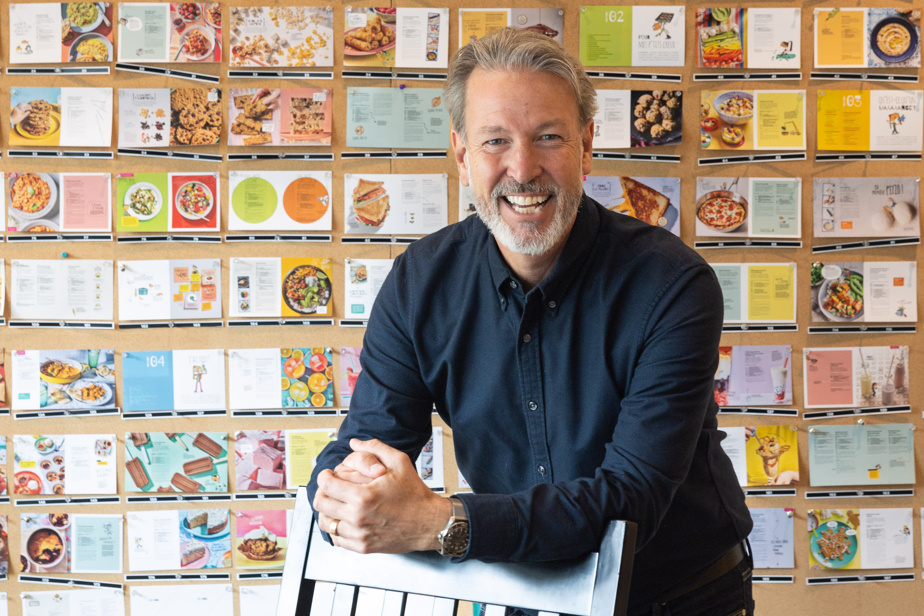Since 2015, generations of little chefs have made their debut in the kitchen with My first recipe book by Ricardo Larrivee, a work which no longer needs any presentation. “It’s our greatest success ever, I think,” says the chef straight away, speaking of his first opus for children, which sold more than 200,000 copies. On this sunny Tuesday morning, we are seated in his large office in Saint-Lambert, a former industrial building where the light floods in, in front of a fruit salad and grapefruit bread, a classic of the house.
So why did you wait so long before releasing a sequel? “First of all, because to make a volume 2, you really have to be convinced that you have something to say,” Ricardo reflects, before mentioning the moral weight that comes with such a thing. “I find that there is nothing more difficult than writing a book for children. For me, it’s the most stimulating thing, but it’s also my greatest anxiety. As soon as we address young people, we know that it could have an influence on the rest of their lives. That’s why I revere teachers so much,” underlines the man who was part of the Lab-École with the architect Pierre Thibault and the triathlete Pierre Lavoie.

PHOTO MARTIN TREMBLAY, THE PRESS
We met Ricardo in his sunny office in Saint-Lambert.
Creating a book
In the office, pinned to the wall, a colorful mosaic represents the 90 or so recipes that dot this second volume.
They offer lunches, snacks, more complex dishes, drinks and, of course, desserts! Advice and explanations are also skillfully disseminated, which children can find throughout the pages, between two recipes. “We wanted to share content, as much on anti-waste as on organic, or on how to read a label,” continues Ricardo. We dissected all the information into bubbles, pieces, or mini-paragraphs, telling ourselves that over five or six years, they will have seen everything. »

PHOTO PROVIDED BY ÉDITIONS LA PRESSE
These cheesy ramen noodles were inspired by TikTok.
As with the first volume, Ricardo and his team relied on their community and their instincts to create the dishes. But in order to really take the pulse of teenagers, they also went to see what was happening on Instagram and TikTok. “We cannot ignore it. What interests them? What are they cooking? », Raises Ricardo. At least two recipes in the book came from this approach, including cheesy ramen noodles and taco burgers.
It was also important that the recipes were accessible to everyone. To this end, the team toured the province’s supermarkets, large and small, to ensure that the ingredients were available everywhere and not just in large centers. “That doesn’t mean I’m going to deprive myself, but if I know that a particular product is difficult to find, I’ll provide alternatives. We have to think about our recipes based on that, especially for a young person. I’m not here to discourage him with things he doesn’t know about. »
Other aspects must also be taken into account, adds Ricardo, such as the portions, the number of ingredients, the time required and, also, the danger. “I love fish and chips, but we won’t use the fryer!” You can make them in the air fryer, in the oven, on a plate… One day, you’ll be 25, then I’ll show you how to make fish and chips differently. »
The fact remains that we are not reinventing the wheel, whether we are addressing children, adolescents or adults. “They are the same ingredients; it’s the methodology that is different.
A soup is a soup, there are no children’s soups. This is why I hate children’s menus in restaurants so much! For me, this is an aberration that should not exist.
Ricardo Larrivee

PHOTO PROVIDED BY ÉDITIONS LA PRESSE
There are obviously desserts in this second volume, like chocolate and berry cookies.
Eat together
Ultimately, this book shows how to cook, yes, but above all how to eat as a family, maintains Ricardo. An aspect that matters even more than culinary skills. “It’s funny to say, but the most important thing for me is not the food, it’s the ‘whole’. I’ve always joked that it’s much better to eat Kraft Dinner with your family than foie gras alone! »
Because if there is one thing that is universal, it is nourishment. And it starts in the family kitchen, with the help of our first recipe book. With which we will perhaps even move into an apartment, years later…

My first cookbook, volume 2
Editions La Presse
200 pages
We tested… the coconut-pineapple smoothie
Our almost 4 year old is a little too small to cook for himself. He does, however, love making smoothies – and above all, let’s be honest, using the blender. With him, we tried the deliciously tangy coconut-pineapple smoothie, which our little chef preferred to make rather than drink!

PHOTO PROVIDED BY THE PUBLISHER
Image taken from My first cookbook, volume 2
Coconut-pineapple smoothie
- Preparation: 10 minutes
- Servings: 2
Ingredients
- 145g (1 cup) frozen pineapple cubes
- 125ml (1/2 cup) pineapple or orange juice
- 125ml (1/2 cup) coconut milk
- 15ml (1 tbsp. tbsp) lime juice
- 1/2 ripe banana, cut into slices
Preparation
In a blender, puree all ingredients until smooth. Divide into 2 glasses. Serve immediately.
